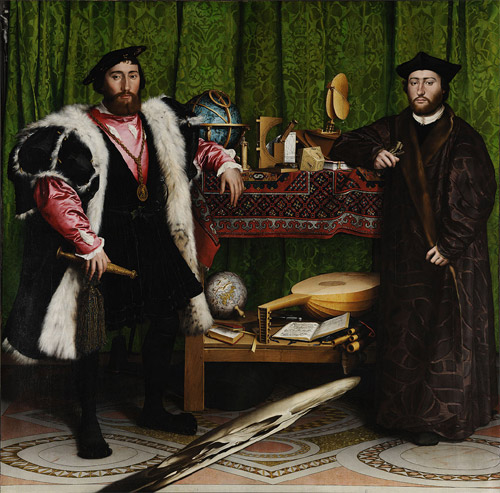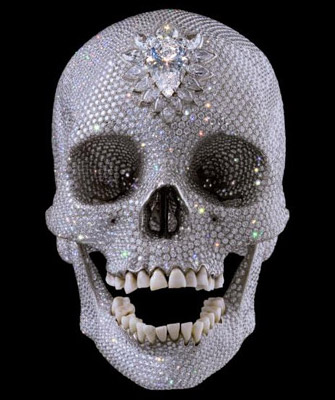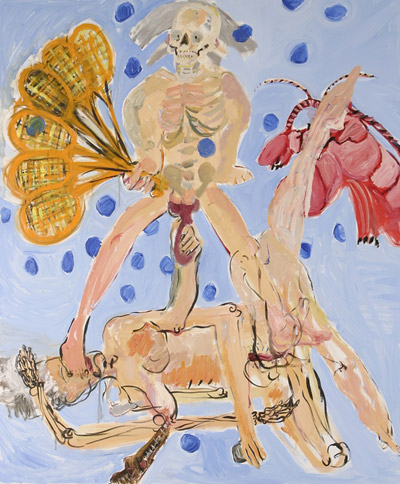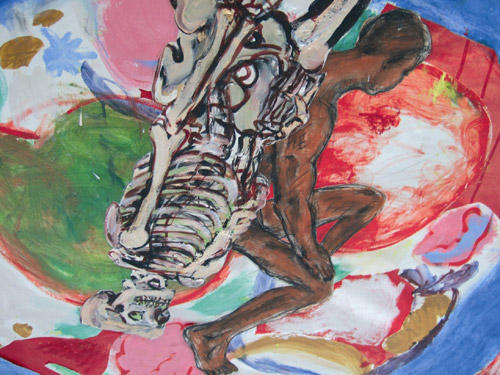
| HOME |
| NERVE |
| REVIEWS |
| ARCHIVE |
| EVENTS |
| LINKS |
| ABOUT US |
| CONTRIBUTORS |
| BACK ISSUES |
| CONTACT US |
The Vanitas Tradition in Western Art
By Sandra Gibson - 9/3/2015
History aficionados will be waiting eagerly for Hilary Mantel to write the follow-up to the excellent Wolf Hall, the everyday story of Tudor wives, written about a time when power cuts did not so much apply to the candle bill but rather, affected the neck. The series on BBC 2 was permeated with the threat of death: from plague, from childbirth, from religious heresy, from rivalries at court. Or from failing to please Henry whose regal omnipotence is never in doubt, whether you are a wife giving birth to the wrong gender of heir or a cardinal taxed with the job of sorting out the Pope and making way for the next womb.
The Who's Who of the Court of Henry XIII originally came to us courtesy of supreme portraitist Hans Holbein the younger, whose depiction of the King is everyone's enduring image of him: physically dense and implacably despotic. He also gave us Thomas Cromwell, Henry's most influential minister, clad in black and pale of face, like all Machiavellian schemers and the focus of Mantel's masterly examination of religious, judicial and political strife at a pivotal time in English history. Despite his efficiency as a dissolver of monasteries, Cromwell was all too aware of his fragile position at court, which, like Anne Boleyn's, was poised on the whim of a fickle monarch: one step away from an executioner's sword. The much discussed darkness in the production not only gave an authentic look to the sets, it also conveyed a sense of impending doom, a darkness not just caused by the current conflicted situation but creating a metaphor for the Tudor world view. Basically, the Grim Reaper is out to get you sooner or later; life is brief and you don't know when it's going to be your turn. Take Sir Thomas More's advice and look to the life eternal, not the life of hedonism and worldly concerns because if you don't get your priorities right you'll end up in a Hieronymus Bosch painting - the one where they don't have wings or play harps.
 |
Hans Holbein's most celebrated painting is The Ambassadors, a double portrait of powerful, learned men, which also presents a visual summary of the themes and tensions of the time: luxury, learning, trade, the tension between the Church and scholarship; religious strife. But the crucial point of the painting is the centrally positioned anamorphic skull which is only decipherable when viewed from a certain angle. If you see the ambassadors and all the other paraphernalia you can't see the skull; if you see the skull you don't get the rest. In other words, there is a dominating memento mori that we usually choose not to see because we focus on the worldly attributes of our lives; but it is still there. Seeing it requires a decision and an effort to re-focus. This tradition of vanitas in the arts and in religious teaching was common. Emblems such as skulls, bones, measuring devices, time pieces, decaying fruit and mirrors were used to evoke a sense of mortality. Who could forget the scene in which Hamlet comes across the skull of poor old Yorick, whom he knew so well in life, or Snow White's stepmother consulting her mirror for reassurance that she has not lost her charms? One imagines Anne Boleyn doing the same thing.
The vanitas genre is usually associated with Northern Europe but its symbols are also found in the work of later artists from Southern Europe, such as Cezanne and Picasso. Has it endured into recent times? Does it still have a place in a culture no longer permeated with religion? I have looked at the work of three modern artists: Andy Warhol, Damien Hirst and Elizabeth Cope and discovered that the imagery so common in old paintings is current today.
Andy Warhol's work reflects the imagery of a hedonistic society, based on capitalism and technology and supported by the mass media, where everything is a commodity. But this is only one facet; his art is also imbued with a sense of life's brevity, usually expressed through the associative idea of fame. He produced series of screen-printed images of iconic people, places and edifices, making the point that the techniques of mass production and mass communication commodify them for global consumption. An icon such as Marilyn Monroe had, and continues to have, a strong cultural presence. Images of her have been cloned like tins of soup and this is what Warhol acknowledges.
 |
 |
But he also presents the fragility of presence: so many of our icons experience loss of status or have had early and sudden deaths. Elvis, Martin Luther King, John F. Kennedy, Marilyn Monroe and, indeed, Anne Boleyn or Thomas Cromwell can be all-pervasive and thriving: as celebrity, actor, goddess, President's consort, queen, statesman, whatever, but their position is tenuous and often dependent on fickle whim, or the executioner's precise action. We are fascinated by celebrity, by flawed celebrity, by the impermanence of fame and by untimely death. Taking place in the obscene gaze of publicity, these are our contemporary public executions. Our current myths echo the old myths and Warhol has used the media as part of the message.
And there's always a Jane Seymour waiting in the wings for her fifteen minutes.
In one of the Marilyn series at Tate Liverpool the garish colours of popular appeal contain areas of unclarity and obliteration - those tantalizing aspects of the elevated person we cannot see - and give way to a progression from black to white to fade. There is a similar sense of dissolution in the silvery Elvis image. These suggestions of the fadeout of celebrity to obscurity or of the life force to death are set against the publicity of the tabloid presence. In the Kennedy series, assassin Lee Harvey Oswald is unmistakeable, though indistinct and grainy as all newsprint can be. One of the works is back to black; another is a gap - there are eleven pictures and a twelfth implied. The series is discontinued rather than finished.
The skull as an emblem is also present in Warhol's work - who can obliterate his skeletal face framed by his spiked "fright wig"? In the recent Tate Liverpool exhibition a work depicting six skulls, deliberately lit to cast emphatic shadows, was exhibited: a compelling and instantly recognizable reminder. But what of a remedy? Holbein left us a discreet religious icon in The Ambassadors but Warhol offers what? He offers recognition of the human condition but no comfort.
If Warhol reminded us, Damien Hirst rubbed our noses in it. "Every art work that has ever interested me is about death," he said, and this has set the tone. One of his earliest works: A Thousand Years, shocked by its actual show-casing of maggots feeding off a severed cow's head. To continue the execution theme, hatched flies blundered into an insectocutor whilst survivors completed the cycle by producing more maggots. The piece was admired by Bacon and Hirst has acknowledged his debt to this artist, famed for his visceral images and existential screams.
In 2007, at an asking price of fifty million ponds, Hirst's memento mori, For the Love of God was exhibited. A human skull was recreated in platinum and decorated with 8,601 diamonds worth about fifteen million pounds, the only surviving part of the original eighteenth century skull being the teeth. He said that diamonds "were the maximum you could pit against death" and went on to say of the completed work that it has a "transcendent and a quiet feel", that although it is a skull, it isn't dark; it reflects light from many points. OK. One can accept the possibility of transforming the energy of something but how can anyone pit anything against death? The answer lies in how the vanitas object was made. Hirst could have produced a facsimile of a skull to be encrusted with diamonds but he bought an actual skull. By retaining the rictus grin and teeth from the original he is making the point that diamonds don't save you from the great realization. Not even slightly. The same point is made by Hirst's use of formaldehyde, the anomaly being that although the substance preserves, it will eventually take its toll on the corpse of the cow or the shark, becoming time's accomplice: an agent of decay. So why display a 'preserved' yet decaying corpse anyway? I maintain that these silenced, suspended creatures are emblems of death for the Botox generation. Science and technology can slow down the ageing process but the guy with the scythe will still get us in the end, however much we rattle our jewels.
And isn't it ironic that Botox, the most toxic and expensive substance on earth, creates the illusion of youthfulness whilst also drawing attention to the dome of skull?
 |
The work of Irish artist Elizabeth Cope combines a Southern European sense of vibrant colour with Northern European expressionism. Around 2008 her paintings began to focus more fully on our bony destiny than previously, although there is always an alligator lurking in the luxuriant shrubbery of her earlier work too. Shockingly visceral, it is only the gallows humour that rescues you from the grand shudder of recognition induced by the works she exhibited in Liverpool 2008, the City of Culture year.
The most savage painting of the collection: Man, Tennis Racquet, Woman is an arresting portrayal of sexual and competitive violence: a skulled and skeletal male figure holds multiple racquets, whilst the supine female figure he is grinding into the ground grasps his scrotum. This combination of violence and vulnerability: the preposterous determination of the will and the fragility of the flesh, together with the imagery of skull and bones is bang-on as an example of the persistence of the vanitas tradition. Like Hirst, Cope uses her re-creative power as an artist to transform the scary stuff. As well as a sense of humour, for her it is a heightened use of colour and patterning combined with the rhythmic interplay of lines and the evocation of compassion for existential suffering, but the images of mortality are there, nevertheless. Does Elizabeth Cope go any further than Warhol or Hirst or, indeed, Holbein in recording this? I think she does. In spite of her skeletons, in spite of her recurring yellow measuring tape, in spite of her view of humanity as humiliatingly trapped by the flesh and the will to dominate, there is a transcendent view present in her work, taken as a whole. Not religious as in Holbein's crucifix, but life-embracing and life-affirming. One of Cope's paintings, (Nest) Lobsters and Skeletons with 3 In One Oil contains a picture within of a skeleton, inverted and back-to-back with a nude. Its head is distorted as if referring a little to Holbein's famous skull and the background is brightly coloured and abstract. This juxtaposition of the living and the dead is not only a memento mori. By virtue of the sense of harmonious balance depicted both in the image and in its background, the artist has created a feeling of acceptance that is not morbid or depressing or frightening. Rather, it is life-affirming in the way that living with death as the obverse of being alive can be. The heightened colour and kinetic intensity of Cope's paintings give a sense that they are resonating with the life force itself.
 |
We all inhabit our own version of Wolf Hall and the media reminds us constantly of life's fragility. In some cultures people are still being decapitated or burned in a cage for their beliefs - or lack of them. Less horrifically, we witness the intrigues and power struggles of our leaders and the short-lived fame of celebrities. Although we live in a secular age, some of the issues dominating the Tudor court are still with us, the biggest being the inevitability of death and artists continue to address this.
www.nationalgallery.org.uk/paintings/hans-holbein-the-younger-the-ambassadors
www.tate.org.uk/whats-on/tate-liverpool/andy-warhol
en.wikipedia.org/wiki/Damien_Hirst
elizabethcope.com/menopausal_series
Sorry Comments Closed
Comment left by Jennifer Guilliard on 15th March, 2015 at 18:03
An absorbing review putting Wolf Hall into the bigger picture of Art and its depiction of mortality and the human condition. Gibson is a talented writer and an avid supporter of the Arts.